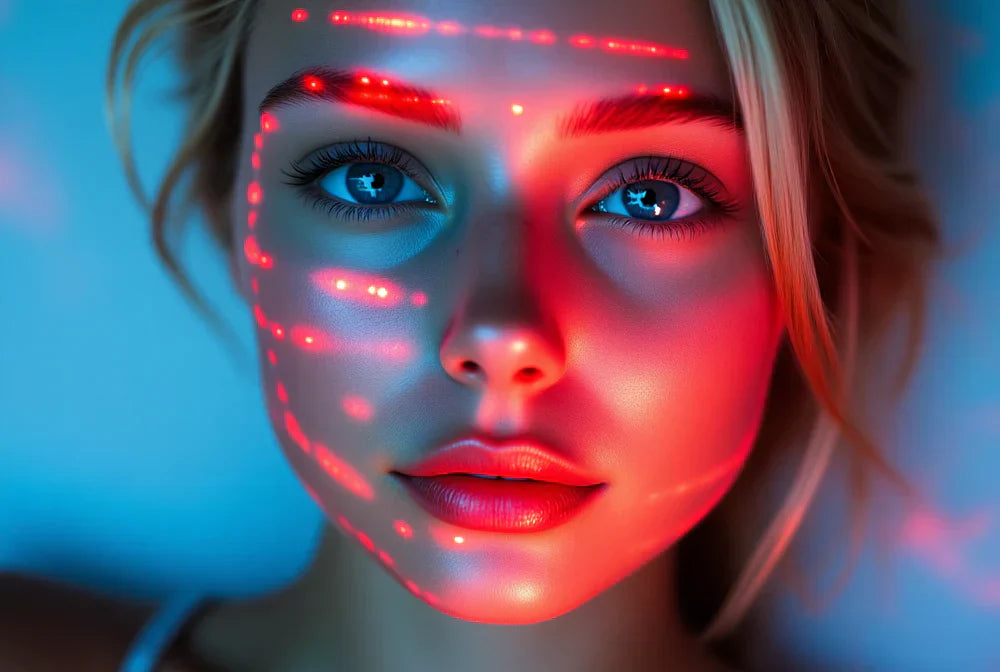Red light therapy and near-infrared therapies, at the forefront of non-invasive treatments, promise to revolutionize your approach to health and beauty in a world where science meets self-care. Whether you're an athlete seeking faster recovery, a skincare enthusiast aiming for a youthful glow, or a chronic pain sufferer searching for relief, these therapies offer hope. However, understanding the differences between red light and near-infrared is crucial for maximizing their potential. This article illuminates the path, giving you the knowledge and confidence to embrace these therapies and transform your wellness journey.
What Is Red Light Therapy?
Red light therapy is a non-invasive treatment that utilizes specific wavelengths of red light to penetrate the skin and stimulate cellular activity. This therapy is renowned for its ability to enhance skin health, promote healing, and reduce inflammation. By energizing the mitochondria, the powerhouse of cells, red light therapy boosts the production of adenosine triphosphate (ATP), which is essential for cellular repair and regeneration. This process can lead to improved skin texture, reduced wrinkles, and accelerated recovery from injuries. Widely embraced by beauty enthusiasts, athletes, and holistic health practitioners, red light therapy offers a natural and effective approach to enhancing overall well-being and vitality.
What Is Near Infrared Therapy?
Near-infrared therapy is a cutting-edge treatment that employs wavelengths just beyond the visible spectrum to penetrate deeper into the body’s tissues, reaching muscles, joints, and even bones. This therapy is celebrated for its profound ability to alleviate pain, reduce inflammation, and enhance circulation, making it a favored choice among athletes, chronic pain sufferers, and holistic health practitioners. By stimulating cellular processes at a deeper level, near-infrared light promotes the repair and regeneration of tissues, accelerating healing and improving overall function. Its ability to penetrate more deeply than red light makes it particularly effective for addressing musculoskeletal issues and supporting recovery from injuries, offering a powerful tool for those seeking to optimize their physical health and well-being.
Red Light vs Near Infrared: What’s The Difference?
Wavelength and Penetration Depth
-
Red Light Therapy: Utilizes wavelengths typically ranging from 620 to 750 nanometers. These wavelengths penetrate the skin to a shallow depth, making them ideal for surface-level treatments such as improving skin texture and reducing fine lines and wrinkles.
-
Near Infrared Therapy: Employs wavelengths from approximately 750 to 1200 nanometers. These longer wavelengths penetrate deeper into the body, reaching muscles, joints, and even bones, which makes them suitable for addressing deeper tissue issues like muscle recovery and joint pain relief.
Primary Applications
-
Red Light Therapy: Primarily used for skin health, anti-aging, and surface-level healing. It is effective in stimulating collagen production, reducing inflammation, and enhancing overall skin appearance.
-
Near Infrared Therapy: Focuses on deeper tissue healing, pain relief, and improved circulation. It is often used by athletes and individuals with chronic pain conditions to support recovery and reduce inflammation in muscles and joints.
Mechanism of Action
-
Red Light Therapy: Works by energizing the mitochondria in skin cells, boosting ATP production, which in turn enhances cellular repair and regeneration. This process is particularly beneficial for skin rejuvenation and healing minor wounds.
-
Near Infrared Therapy: Also stimulates mitochondrial activity but at a deeper level, promoting the repair and regeneration of tissues beyond the skin. This makes it effective for reducing inflammation and accelerating the healing of deeper injuries.
Ideal Users
-
Red Light Therapy: Best suited for beauty and skincare consumers, individuals seeking anti-aging solutions, and those interested in improving skin health and appearance.
-
Near Infrared Therapy: Ideal for athletes, fitness enthusiasts, chronic pain sufferers, and anyone looking to enhance recovery from injuries or alleviate deeper musculoskeletal issues.
Can You Use Red Light and NIR At The Same Time?
Absolutely, you can use red light and near-infrared (NIR) therapy simultaneously, and in fact, many of the most effective devices on the market are designed to combine both wavelengths. This dual approach leverages the unique benefits of each type of light, offering a comprehensive treatment that addresses both surface-level and deeper tissue concerns. By using both red light and NIR together, you can enhance skin health and appearance while also promoting deeper healing and pain relief. This combination is particularly beneficial for individuals seeking holistic wellness solutions, as it maximizes the therapeutic potential of light therapy, providing a versatile and powerful tool for improving overall well-being. Whether you're aiming to rejuvenate your skin, accelerate recovery, or alleviate chronic pain, using a device that integrates both red light and NIR can offer a synergistic effect, optimizing your health outcomes.
Is Far Red Light The Same As Infrared?
Far red light and infrared light are related but distinct in terms of their wavelengths and applications. Far red light typically refers to wavelengths ranging from about 700 to 750 nanometers, sitting at the edge of the visible spectrum. It is often used in conjunction with red light therapy to enhance skin health and surface-level treatments. Infrared light, on the other hand, encompasses a broader range of wavelengths beyond the visible spectrum, starting from around 750 nanometers and extending into the thousands. Infrared is further divided into near, mid, and far-infrared categories, each penetrating the body to different depths and offering unique therapeutic benefits. While far red light is primarily used for superficial applications, infrared light, particularly near-infrared, is utilized for deeper tissue healing, pain relief, and improved circulation. Understanding these distinctions allows for more targeted and effective use of light therapies tailored to specific health and wellness needs.
How Often Should I Use These Therapies?
The frequency of using red light and near-infrared therapies can vary based on individual goals, the specific condition being addressed, and the device being used. Generally, for most applications, it is recommended to start with sessions three to five times per week, each lasting about 10 to 20 minutes. This frequency allows your body to adapt and respond to the therapy, promoting optimal results without overwhelming your system. As you begin to notice improvements, you can adjust the frequency to maintain results, often reducing to two to three times per week. It's important to follow the manufacturer's guidelines and consult with a healthcare professional if you have specific health concerns or conditions. Consistency is key, and integrating these therapies into your regular wellness routine can help you achieve and sustain the desired benefits over time.
Tips For Using Red Light and Infrared Devices
-
Start with Clean Skin: Before using red light and infrared devices, ensure your skin is clean and free from any lotions, oils, or makeup. This allows the light to penetrate more effectively and ensures optimal absorption and results.
-
Follow Recommended Usage Times: Adhere to the manufacturer's guidelines regarding session duration and frequency. Overuse can lead to diminishing returns, while underuse may not provide the desired benefits. Consistency is key to achieving the best outcomes.
-
Position the Device Correctly: Maintain the recommended distance between the device and your skin, usually a few inches, to ensure the light covers the target area effectively. Some devices may require direct contact, while others work best at a slight distance.
-
Incorporate into Your Routine: Integrate light therapy sessions into your daily or weekly wellness routine. Whether it's part of your morning ritual or evening relaxation, regular use can enhance the cumulative benefits over time.
-
Monitor Your Progress: Keep track of your results by taking notes or photos of your skin or areas of concern before and after starting treatment. This helps you assess the effectiveness of the therapy and make any necessary adjustments to your regimen.
Conclusion
In the dynamic realm of health and wellness, understanding the distinctions and synergies between red light and near-infrared therapies empowers you to make informed decisions that align with your personal goals. These therapies, whether used individually or in combination, offer a versatile and non-invasive approach to enhancing skin health, accelerating recovery, and alleviating pain. By integrating these powerful tools into your wellness routine, you can unlock a new level of vitality and well-being, harnessing the science of light to illuminate your path to optimal health. As you embark on this journey, remember that consistency and informed choices are your allies in achieving the transformative benefits that red light and near-infrared therapies promise.
Final Thoughts
Wondering how to integrate red light and near-infrared therapies into your daily life? Discover EMR-TEK, where we provide innovative solutions tailored to fit seamlessly into your lifestyle. Whether you're looking for a portable device for travel or a comprehensive system for home or professional environments, we have the perfect solution for you. Our blue light glasses are designed to reduce eye strain, making them a crucial addition to your wellness routine. Explore our collection of red light therapy products and begin your journey to achieving healthier, more youthful skin today.
Sources
1. https://en.wikipedia.org/wiki/Far-red_light
2. https://onlinelibrary.wiley.com/doi/10.1111/php.13550
3. https://www.sciencedirect.com/topics/biochemistry-genetics-and-molecular-biology/cell-stimulation
Disclaimer*: EMR-TEK’s red infrared light therapy devices, blue light blocking glasses, and other products are intended solely for personal wellness and fitness use. They are not designed to diagnose, treat, cure, or prevent any disease and should not be considered medical devices. We do not make any therapeutic claims. Our products align with the FDA’s “General Wellness: Policy on Low Risk Devices” guidelines and do not require FDA clearance. Please note, EMR-TEK’s products are for personal use only and not for commercial application.*




Share:
How To Tell If Glasses Are Blue Light: Blue Light Glasses Tips
How To Get Rid Of 11 Lines: Step-by-Step